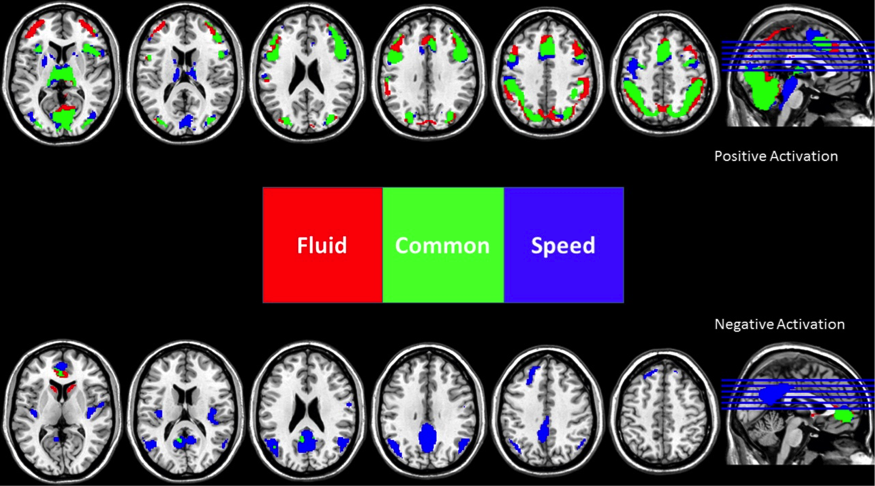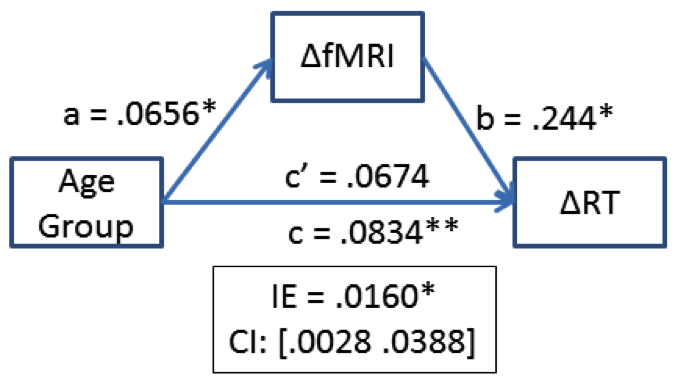Columbia University
Irving Medical Center
Neurological Institute
710 West 168th Street, 3rd floor
(212) 305-1818
TaubCONNECT Research Perspectives:
May 2015
» #2 Functional Network Mediates Age-related Differences in Reaction Time: a Replication and Extension Study
» #3 Self-Efficacy Buffers the Relationship between Educational Disadvantage and Executive Functioning
 |
 |
| Christian Habeck, PhD | Yaakov Stern, PhD |
Recently published in the Journal of Cognitive Neuroscience, this paper by Habeck et al. identifies fundamental neural networks for two basic cognitive reference abilities that are to some extent underlying all cognitive processes. 106 participants across the whole adult age range (age 20 -80) were subjected to fMRI scanning while performing six tasks, with three tasks each belonging to two different cognitive "reference abilities": (1) fluid reasoning and (2) perceptual processing speed. The paper found two separate brain activation patterns employed when people engaged in tasks of either reference ability. On the basis of these two separate activation patterns, the type of cognitive process underlying any activation map in the study could be predicted with high accuracy, even in independent data that had not been used in the original derivation of the two activation patterns. Fluid-reasoning tasks gave rise to task-maps that better matched the fluid-reasoning activation pattern, whereas the converse was true for perceptual-speed tasks.
Our complete data base, consisting of 12 cognitive tasks that are imaged in over 300 people at this stage, allows the empirical test of relationships that seem a priori fundamental and self-evident, but could so far not be verified because of a paucity of data. One such relationship concerns the similarity of behavioral performance and the similarity of topographic composition of the corresponding neural activation maps: any two tasks that are similar from the point of view of behavioral performance (and consequently show high correlation of behavioral performance across subjects) are also similar in terms of the topographic composition of the underlying neural activation maps (and consequently show correlation of activation maps across locations in the brain). The Taub Institute's Cognitive Neuroscience of Aging Laboratory allows the interrogation of such fundamental relationships and their possibly changing nature as people's brains change with age. This is interesting not only from a basic cognitive-neuroscience perspective, but might also have diagnostic and prognostic applications.
 Figure 5 from the JOCN: Select axial slices of the unique parts of the FR (red) and PS (blue) RANNs as well as common parts (green). Shown are areas of mean activation across the three tasks in each reference domain, which survive a significance threshold of p < .05, corrected for the number of voxels in our analysis. The upper row shows areas of activation, and the lower row shows areas of deactivation. One can appreciate that large parts of frontal, parietal, and occipital lobe activate in common, but only one frontal pole area deactivates in common.
|
Christian Habeck, PhD
Associate Professor of Neuropsychology
ch629@cumc.columbia.edu
Yaakov Stern, PhD
Professor of Neuropsychology
ys11@cumc.columbia.edu
 |
 |
| Yunglin Gazes, PhD | Yaakov Stern, PhD |
A prominent change as we age is in the ability to switch between different tasks. Recently published in Brain and Behavior, this study is a replication and an extension of a previous finding examining the functional activation during a task-switching paradigm and its relation to task-switching performance. The authors forward applied the previously derived functional activation pattern to a new group of participants consisting of both young and older adults and showed that the pattern significantly predicted the increase in reaction time from single-task to task-switching condition. Furthermore, the patterns also mediated the effect of age on the reaction time increase in both young and older adults. The results demonstrated the predictive power of the functional activation pattern during task-switching. More importantly, the study presented evidence supporting the influence of functional activation on age-related differences in task-switching performance.
This study is part of the Taub Institute's multimodal research program in cognitive neuroscience, which seeks to understand the multifaceted changes occurring in the brain as we age and how that affect our behavior and our cognition. To follow up on the results of this study, the Cognitive Neuroscience of Aging Laboratory is investigating various techniques to combine structural changes such as cortical thickness and white matter integrity with functional activations during task performance to predict age-related changes in cognition. Ultimately, we hope to fully characterize the changes in the brain as we age and relate that to the changes in our cognition.
 Figure: Illustration of the mediation of Age group on ΔRT by ΔfMRI expression, supporting an influential role for the brain activation differences on the age-related differences on reaction time. a = beta for the effect of Age Group on ΔfMRI expression; b = beta for the effect of ΔfMRI on ΔRT; c = total effect of Age Group on ΔRT; c' = effect of Age Group on ΔRT controlling for ΔfMRI; IE = indirect effect of Age Group on ΔRT through ΔfMRI; CI = 95% confidence interval for the indirect effect.
|
This study is part of the Taub Institute's multimodal research program in cognitive neuroscience, which seeks to understand the multifaceted changes occurring in the brain as we age and how that affect our behavior and our cognition. To follow up on the results of this study, the Cognitive Neuroscience of Aging Laboratory is investigating various techniques to combine structural changes such as cortical thickness and white matter integrity with functional activations during task performance to predict age-related changes in cognition. Ultimately, we hope to fully characterize the changes in the brain as we age and relate that to the changes in our cognition.
Yunglin Gazes, PhD
Assistant Professor of Neuropsychology
yl2107@cumc.columbia.edu
Yaakov Stern, PhD
Professor of Neuropsychology
ys11@cumc.columbia.edu
Self-Efficacy Buffers the Relationship between Educational Disadvantage and Executive Functioning
 |
 |
| Laura Zahodne, PhD | Jennifer Manly, PhD |
It is well known that higher education is associated with better cognitive functioning in adulthood. However, some individuals with relatively low education perform at a level comparable to that of more highly-educated individuals, which indicates the presence of resilience factors that reduce the negative impact of educational disadvantage. This study by Zahodne et al., recently published in the Journal of the International Neuropsychological Society, explored whether self-efficacy beliefs might represent such a resilience factor.
A high sense of self-efficacy corresponds to strong confidence in one's ability to perform well. People with high self-efficacy approach difficult tasks as challenges to be mastered rather than threats to be avoided. In the face of failure, they increase rather than decrease their efforts. Having high self-efficacy may improve cognitive performance by enhancing motivation and/or reducing stress reactivity. Indeed, longitudinal studies show that higher self-efficacy is associated with better cognitive performance later in life (but not vice versa).
In this study, 1,032 adults aged 30-85 living throughout the U.S. completed Cognition and Emotion modules from the NIH Toolbox, a standardized set of computer-based neurobehavioral measures. Not surprisingly, higher education was associated with better performance in all cognitive domains: executive function (set-shifting, attention/inhibition), working memory, processing speed, episodic memory, and vocabulary. On average, higher education was also associated with higher self-efficacy beliefs. However, individuals with low education and high self-efficacy performed just as well on executive tasks as individuals with high education. Specifically, scoring one standard deviation higher on the NIH Toolbox Self-Efficacy Survey was equivalent to 1.5 additional years of education. This effect was independent of age, sex, race/ethnicity, reading level, testing language (English or Spanish), and depressive symptoms. Among individuals with high education, self-efficacy was not associated with executive functioning, suggesting that situational and environmental benefits afforded by higher education overpower the influence of individual differences in psychological factors such as self-efficacy.
Although this study was cross-sectional, results are compatible with the view that enhancing self-efficacy beliefs could lead to better executive performance in the setting of low education. Indeed, positive youth development programs that incorporate strategies for enhancing self-efficacy show the strongest positive impact on academic outcomes, and enhancing self-efficacy through implicit activation of positive stereotypes of aging leads to better cognitive performance among older adults in an experimental setting. Together, these results support targeting psychological resilience factors such as self-efficacy in future policy and/or intervention work aimed at reducing the deleterious effects of educational disadvantage on later cognitive health.
Laura Zahodne, PhD
Associate Research Scientist
lbz2105@cumc.columbia.edu
Jennifer Manly, PhD
Professor of Neuropsychology (in Neurology, the Gertrude H. Sergievsky Center and the Taub Institute)
jjm71@cumc.columbia.edu

